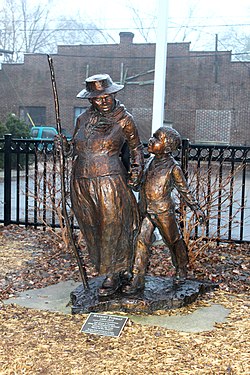Installations
The statue was made in an edition of seven. Critics have noted that the statue's expression suggests Tubman's "gentle caring manner and generosity." [2]
The statue in Ypsilanti, Michigan, was unveiled on 21 May, 2006, as part of a redevelopment of a plaza adjacent to the Ypsilanti District Library. [3] Two years later, the library board added a plaque to the statue describing Tubman's life and achievements as a response to local queries about the statue; the original plaque was located at the base of the rear of the statue in an area difficult to read easily. [4] The plaque and statue commemorate Ypsilanti's connection to the Underground Railroad. [5]
The one in Little Rock, Arkansas, was originally placed in Little Rock's Riverfront Park; however, during the construction of the Game and Fish Nature Center in the park it was relocated to the entrance of Clinton Presidential Center [6] as part of a series of six pieces of art lining a walkway from the downtown area of Little Rock to the Presidential Center. [7]
The one in Gainesville, Georgia, is located at the entrance to Thurmond–McRae Lecture Hall on the campus of Brenau University. [8] Its installation was the first instance of an educational institution in the southern United States honoring Tubman in such a visible way. [9] A further identical statue is located on the campus of Brenau University in Gainesville, Georgia.
This page is based on this
Wikipedia article Text is available under the
CC BY-SA 4.0 license; additional terms may apply.
Images, videos and audio are available under their respective licenses.

